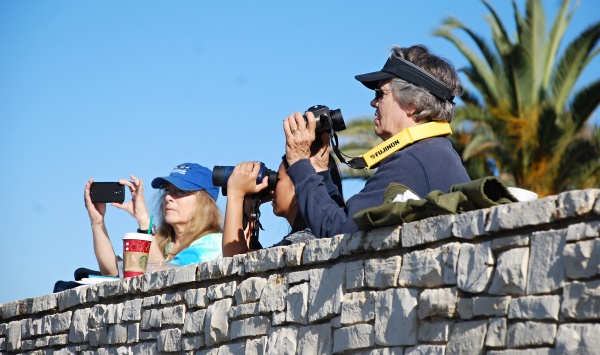There were many auspicious signs on the first day of the gray whale census at Pt. Vicente Interpretive Center in Palos Verdes where a group of faithful volunteers were shining up their binoculars for the annual cetacean count.
In addition to spying a gray whale at about 7:30am – the official first one of the season which runs Dec. 1, 2013 through May 20, 2014 – volunteers were treated to a naked paddle boarder who was doing his own commune with nature on this early Sunday morning.

“He better put some sun lotion on himself,” says one volunteer scanning the northern horizon in the direction of Malibu. “Never expected that today,” remarks another who was searching the relatively calm coastline. While the au natural athlete was a nice diversion and worth a couple of jokes, this group definitely was more fired up to describe the earlier whale, how it swam closer and closer until it was right off the cliffs below. “Then it blew and you could hear it!” exclaims another volunteer. “It was just amazing!”
Sponsored by the Los Angeles Chapter of the American Cetacean Society (ACS), the Gray Whale Census and Behavior Project has been around since 1979 with three pilotons for the 1979-80, 1980-81 and 1981-82 seasons; these were just a few weeks to a few months long, not full day or full season. There was no census in 1982-83 season but it was established as a full day, full season event in January 1984.
The census relies on trained volunteers from the ACS, the Cabrillo Whalewatch program and the general public. These shoreline searchers assist scientists by recording behavior and counting gray whales that are making their annual migration from the cold arctic waters of Russia and Alaska to the warm lagoons of Baja, Mexico where they will mate and birth calves. Some whales, however, can’t wait and make the trek pregnant.

It’s estimated that there are between 20-22,000 gray whales in the Eastern North Pacific Ocean that make the 10,000+ mile trek, the longest migration for any mammal. Other marine critters are also noted in the daily log – blue whales, fin whales, dolphins, etc. but the emphasis is always on the grays.
The Gray Whale Census is a granddaddy in today’s world of numerous citizen scientist programs; given its longevity, the annual count is helping marine biologists better understand how the gray marine mammal is faring overall. It’s not an official number of whales, (most southbound whales prefer a pathway on the outer side of Catalina Island while northbound whale like the near shore route) but rather “a snapshot of what is happening to them,” says census project director Alisa Schulman-Janiger who has been instrumental in organizing and promoting the count. “It’s baseline data in a long term study.”
Schulman-Janiger remembers when the census was done at Marineland and nearby Long Point; she also recalls volunteer counters who braved the elements on Santa Catalina Island (“Then the bald eagle decided to nest in our campsite so that kicked us out of there.”)
For the last five years, the cetacean spotters have gathered on the patio at the Interpretive Center which offers sweeping vistas on a cliff side about 125 feet above sea level. Numbered fence posts help counters record swimming whales.

Today, Schulman-Janiger is giving new volunteers orientation, explaining how to fill out the daily log, how to use the project binoculars, and what to expect on a shift (which happens rain or shine, windy or calm) along with a little primer on local marine wildlife. There’s an air of excitement; last year was a very good year for the whale spotters with 771 being recorded heading southbound (including 21 calves) and 1,152 seen swimming northbound (with 138 calves).

The backburner question for the day: What will be the scene for this year’s migrators?
“Overall timing of the migration will probably be later in the year,” says Wayne Perryman, a biologist with the Southwest Fishery Science Center who keeps track of the arctic ice conditions which can affect the health of the whales including pregnant and soon-to-be pregnant females. “There’s a strong relationship between the melt of the ice and the number of calves,” he explains but then adds, “Of course, that didn’t happen last year. We had good calf numbers but the ice wasn’t as good. Last year didn’t follow the usual pattern.”
This year, Perryman makes an educated guess that census spotters should have a good year for counting with “little downturn in calf numbers coming north in the spring from last year.”

Back at the Gray Whale Central, volunteers are cheering for a small pod of common dolphin that are frolicking to the south; out and up they hurl, curve and arc they splash down. Last year, more than 86 volunteers racked up 9,950 hours at the count.
A quick survey revealed today’s volunteers have 30 and 23, 6 and 3 years under their respected belts. “It’s the camaraderie,” they say about why they come here every day from sunrise to sunset. “It’s being part of something bigger and learning about the wildlife,” says another who passes a plate of cheese and crackers to her fellow volunteers. “I love being out here,” concurs a very excited volunteer. “I feel like I am in the Garden of Eden.”

Information on daily sightings, visit ACS/LA Gray Whale Census
— Story by Brenda Rees, editor
